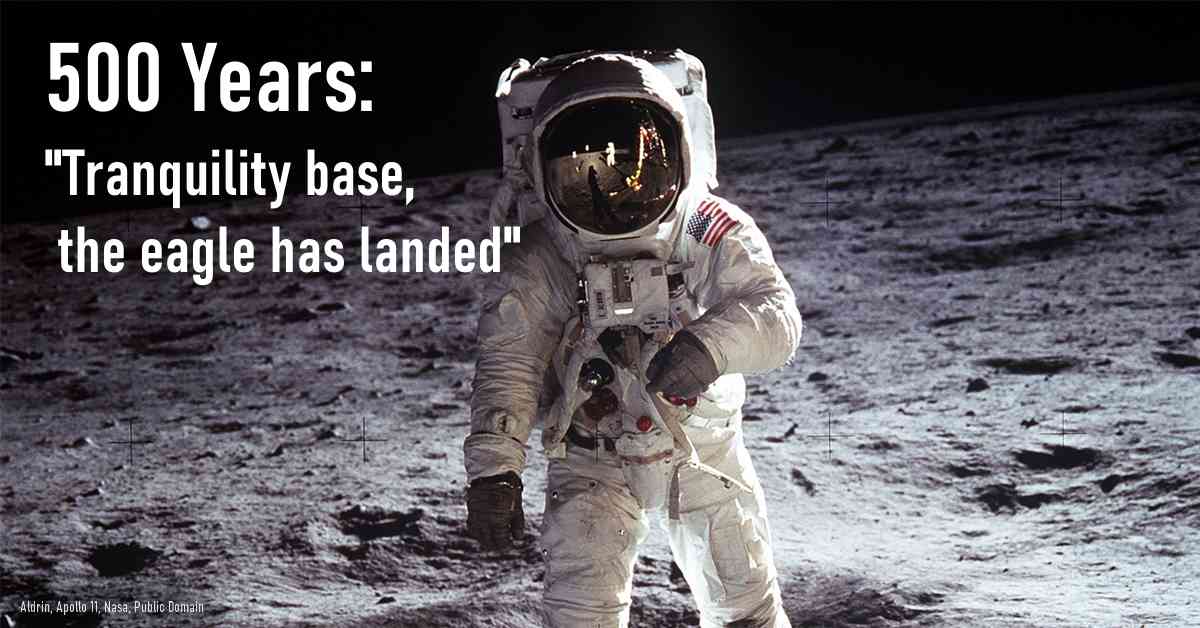
2469 500th Anniversary of the First Moon Landing

The first human activities in the decades "after Tranquility" were characterized by few low-flying space stations and occasional orbital flights, propelled by large and expensive chemical rockets. Since then, much has changed.
Today, 40 million people live permanently in interplanetary space, on the inner planets and the outer moons. Small "tin cans" have given way to spacious habitats. Megatons of material is sent into orbit by laser launchers and linear accelerators. And the orbital transfer is even more extensive, because Earth and Mars orbit are much closer to each other energetically – and therefore economically – than the planetary surfaces.
The interplanetary economy is thriving. While there are tensions between the system powers there has been no major military conflict in space recently. Earth's self-imposed isolation has been in place for more than 100 years. Initially, the embargo by Earth was dramatic for space stations and habitats, but the interplanetary civilization has come to terms with the situation. The initial shock has long been overcome with the wider solar system being now independent of Earth. The interplanetary economy is currently in a long-lasting growth phase.
In the previous decade, humanity has made two great leaps forward. Just 11 years prior a spaceship matched the speed of light for the first time in the famous Lighthugger-Flight. And the development of FTL propulsion systems continues to make great progress. The first colony ship with FTL drive has just left the Sol System. Only 42 years later, a period shorter than between the sixth and seventh moon landing, the first interstellar merchant ship will set off for the stars.
Not only space travel has changed fundamentally during the 500 years since Tranquility. Humanity itself has also changed. Most people have genetic optimizations: association boosters, IQ upgrades and artificial savant aspects. Nano-implants provide advanced sensor technology, connectivity and data storage, 4-color vision, and multiple parallel thought processes. The biological bodies stay in good health for 150 years and after that there are perfect biomechanical replacements available. In the age of mind-backups final death is rather unusual, because people can continue to live as mech or in a simulation. With countless gene-mods and nanotech, humans have even adapted to life in space, including ZeroG gene hacks against calcium depletion, nanobot-assisted repair of radiation damage, and feet with opposing toes for a life in zero gravity. Yet not all gene-lines are compatible. The human gene pool is diverging.
Earth and the Sol System had great political turmoil in the past. There were wars, crises, and disasters. There were united world governments and political fragmentation. The civilization collapsed and was rebuilt. Yet, there have been enormous scientific advances, the effects of which have also changed daily life. The face of the Earth looks different now due to climate change and the rising sea levels. But humanity supported by technology has managed to cope with these challenges. Big problems of the 21st century have been solved. The oceans are now being used as living spaces. Energy is cheap and the Earth has just reached a turnaround point from which its ecology is recovering.
The interplanetary civilization has written its own history with religions and ideologies, military conquests and economic conflicts. Great political powers emerged and disappeared: after the isolation of Earth, the Moon/L4/L5 region dominated the system, then the United Mars colonies, later the Ganymede Directorate, and now we are experiencing the rise of the outer system.
The next 500 years will bring as many changes with humanity reaching out into the interstellar neighborhood meeting new opportunities as well as existential risks. The Sol System will be undergoing severe crises, interstellar wars, occupation and liberation, victory and defeat. It will be both, an aggressor, and a victim of conquest. The Sol System will unite and fragment again. Humans will settle other star systems, some of them so far away that they will have an independent future. They will have to find their own ways among other species.
The human sphere will become multipolar other human population centers rising and surpassing the Sol System. And then the new interstellar humanity will be drawn into the dramatic developments of the local sector and will learn that stability is not a given.
Latest Articles
2337 Lunar Takeover
2222 Space Piracy
2366 Orbital Economics
2234 Orbit's End
2333 Metric Impulse Drive
3308 Supernova
3361 First Humanity
2326 No Interplanetary War
2247 Quantum Leap
2312 Alien Spaceship
2158 Space Patrol
2284 Great Separation
2321 Earth Isolation
2205 Corporate Cosmos
2179 Private Asteroid Base
2231 United Planets
2248 Gemini Disaster
2291 Illegal Research
2303 Space Trader Coup
2318 Earth Union
Absolute Highlights
(20 of 62)
2168 Spaceship Udyama
2179 Private Asteroid Base
2312 Alien Spaceship
2321 Earth Isolation
2412 Planet 9
2469 500 Years
2493 Oumuamua
2560 Alien Tech
2630 A Conspiracy is Exposed
2648 Adventurous Journey
2668 Ultra Metals
2681 An Ancient Robot Civilization
2750 Executive Decision
2786 Unimpeded Development
2794 Prophet of the Galactic Traders
2915 FTL Capable Railgun
2997 Alien Religions in Conflict
3110 Fragmentary Outer System
3340 Strategic Initiative
3361 First Humanity
 2460
Ecological Turnaround
2460
Ecological Turnaround

 2471
War on Venus
2471
War on Venus